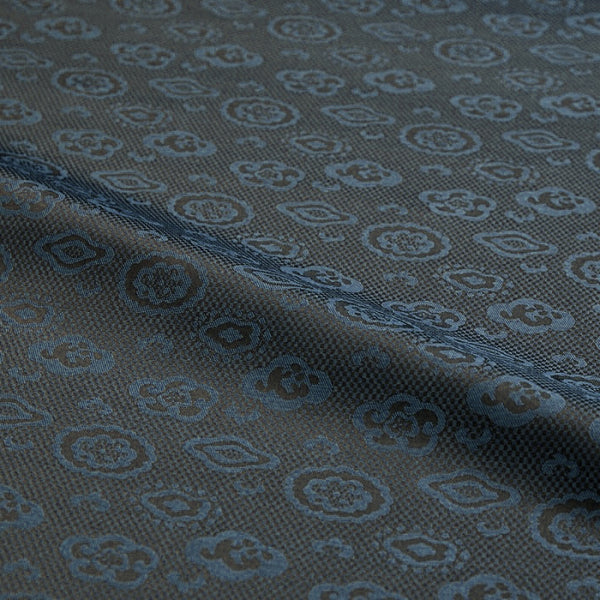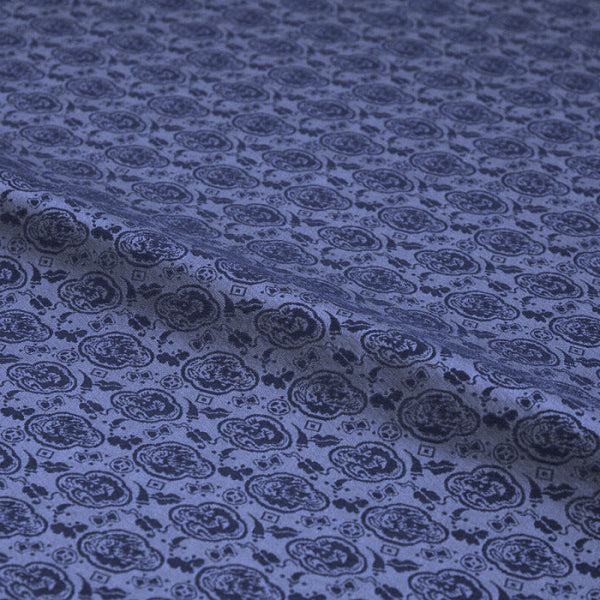Kakejiku Fabric: Kireji
ed: This article was originally published on the former website of Fuh-mi (a Japanese calligrapher who mainly works in the field of contemporary art and who offers many works on our website).
The fabric used to make a kakejiku is referred to as "kireji" (裂地). There are numerous types of kireji available in a variety of materials. The price of the fabric can vary significantly, which has an impact on the price of the kakejiku. Kireji's function, similar to that of a frame in Western painting, is to highlight the calligraphy or artwork; therefore picking the proper one is crucial to creating a beautiful composition.
Kinran and Donsu
There are many different types of kireji available today, made from both natural materials such as silk and cotton, as well as synthetic materials such as rayon, Bemberg, etc. Traditionally, kireji can be divided into two categories: donsu (緞子 - damask) and kinran (金襴 - gold brocade).
Donsu, also known as Japanese damask, was first imported from China and then manufactured in the Kyoto area beginning in the second half of the 16th century. It was mostly used for accessories (kimono belts, pouches, headscarves, and so on), temple furnishings, bride's kimono, and kakejiku. The fabric is made of woven motifs on a glossy satin foundation. Warp and weft can be one or many colours, and made from one to several materials.
The hashira, ten, and chi parts of a kakejiku are typically made in donsu. The most expensive donsu (shōken-donsu) is entirely made of silk, which naturally affects the price of the kakejiku.
Kinran is a variety of donsu that has gold accent threads weaved into it. Kinran is primarily used for the ichimonji lines and fūtai on Yamato and Maru kakejiku. It is more prominent on Butsu kakejiku, notably used for the chūmawashi, or "inner frame." Kinran can be weaved with pure silk and gold threads, or it can be made out of synthetic material.

Shōken-donsu

Kinran
About Kifune Donsu
A medium-sized Yamato-style kakejiku in shōken-donsu can easily cost up to $600 or $700, not including, of course, the value of the artwork.
In order to reduce costs while retaining the exquisite aesthetics of kakejiku, a modern form of donsu was developed in the twentieth century: kifune donsu (貴船緞子). The name kifune comes from the Kibune area in Kyoto. The manufacturing processes are same, but the warp is made of high-quality cotton, and the weft is made of cupro, an artificial thread that resembles silk.

Kifune donsu
Kifune donsu artisans can manufacture the same elaborate designs and rich satin look as silk donsu, making it rather difficult to distinguish between the two types of kireji. Furthermore, kifune donsu is as durable as the original fabric, but it is lighter and easier to maintain.






1 コメント - Kakejiku Fabric: Kireji
Nous venons de recevoir notre commande de 2 hakama Traditionnels japonais.
La fabrication, le tissu, la coupe sont exceptionnels et reflètent le savoir faire ancestrale de votre atelier de fabrication. Nous ne connaissions pas SeidoShop international, c’est un ami, sachant que nous cherchions des Hakama Traditionnels, qui nous a donné vos coordonnées, et nous savons déjà que nous allons faire des heureux. Merci infiniment pour le sérieux, le suivi de la fabrication a l’expédition Tout a été respecté, tarifs et délais de livraison.Les hakama étaient présentés dans des sacs individuels au nom de SEIDO dans la plus pure tradition japonaise. C’est un Site que nous recommandons à tous les pratiquants d’Arts Martiaux Traditionnels Japonais, et que nous allons diffuser au sein de notre école TAKEDA-RYU MAROTO-HA.